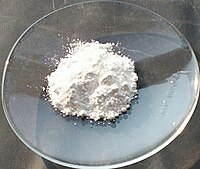
Photo from wikipedia
Abstract Individual oxide semiconductors and metals experience unique pH-dependent phase-transition into natively stable phases (metal, metal ions, or oxide phases) in various acidic and basic solutions. Thus, the corrosion behavior… Click to show full abstract
Abstract Individual oxide semiconductors and metals experience unique pH-dependent phase-transition into natively stable phases (metal, metal ions, or oxide phases) in various acidic and basic solutions. Thus, the corrosion behavior of oxide semiconductors and metals can be engineered by controlling pH values. In particular, the specific pH value induced interesting corrosion behavior that oxide semiconductor becomes chemically-stable and metal solely experiences active ionization. First, the pH-dependent corrosion behavior of ternary oxide semiconductors [ZnSnO (ZTO) and InZnO (IZO)] and common metals (Mo and Mo/Cu) was explored based on theoretical Pourbaix diagram and experimental corrosion data. Next, the pH-dependent corrosion behavior based back-channel wet-etch (BCWE) process using pH-controlled wet etchants was designed and applied for chemical damage-, metal residue-, and curing treatment-free solution-processed oxide thin film transistors (TFTs) circuit integration without electrical degradation. Thick-Mo and thin-Mo/thick-Cu could be completely ionized without any metal oxide residues in middle-basic (pH ≥ 10) and weak-acidic (pH = 6) wet-etchants, respectively. Chemically durable ZTO in the broad pH region (6 ≤ pH ≤ 11) indicated sufficient potential as channel candidates for the circuit integration of chemical damage-free oxide TFTs as opposed to IZO (pH = 10). Finally, solution-processed ZTO TFTs could be fabricated with wet-etched Mo and Mo/Cu using the customized wet-etchant condition (pH = 10 and 6) without electrical degradation (current-drop, hump phenomena, or instability) that was inevitably generated in a conventional BCWE.
Journal Title: Journal of Alloys and Compounds
Year Published: 2017
Link to full text (if available)
Share on Social Media: Sign Up to like & get
recommendations!